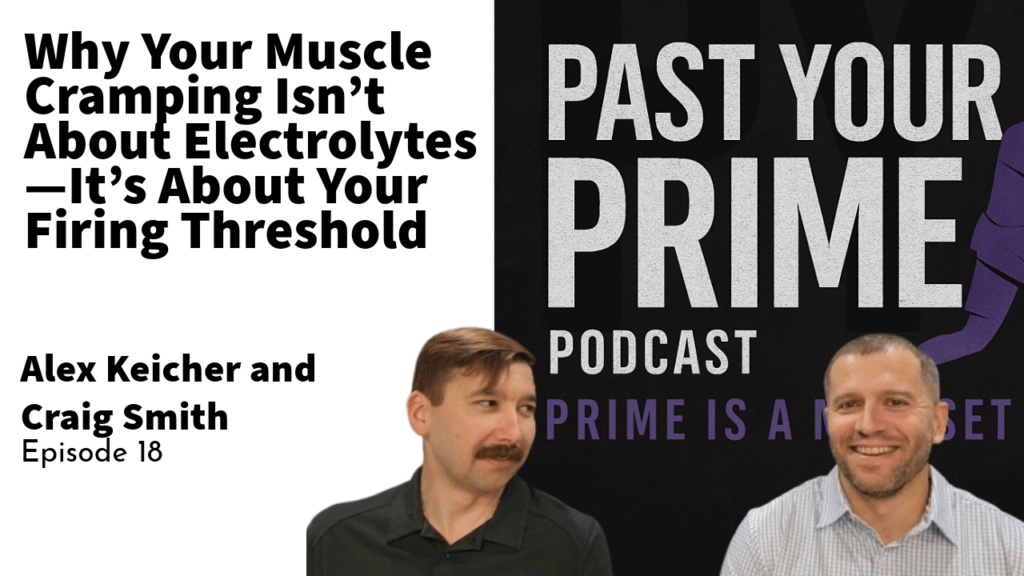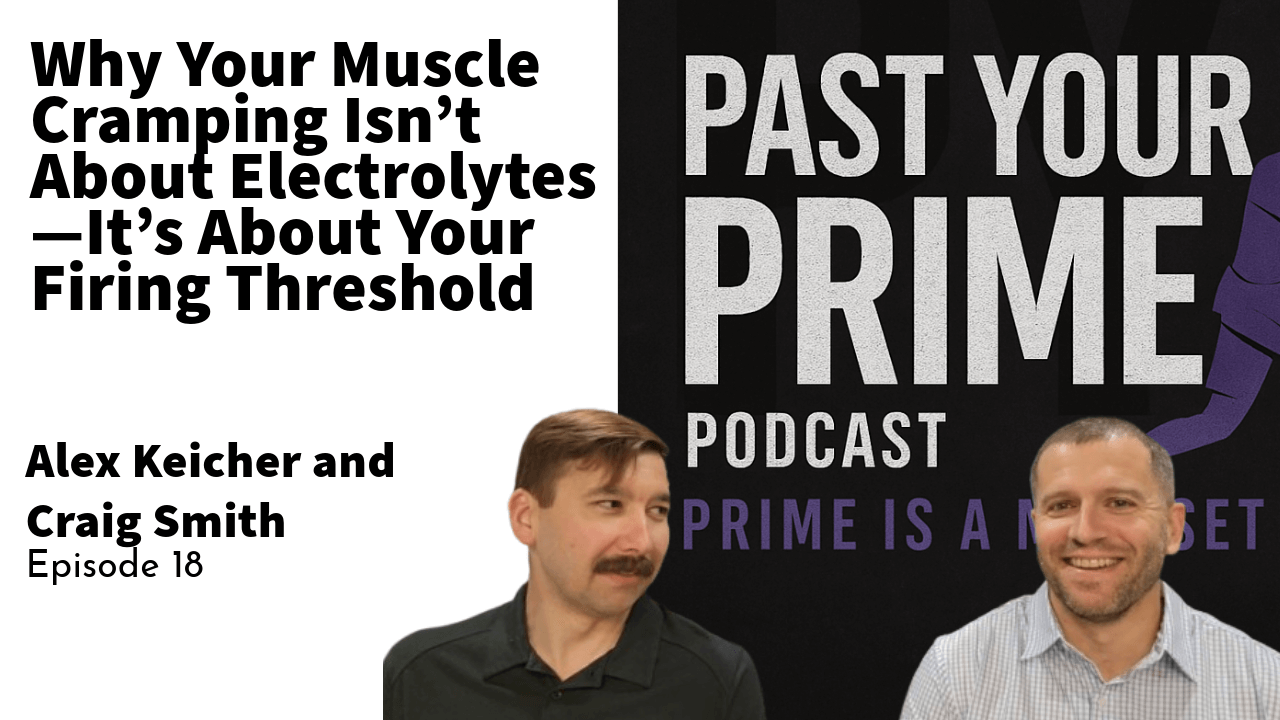Past Your Prime Podcast – Episode 18
You’ve heard the advice a hundred times: “Drink more water.” “Add some electrolytes.” “Stretch it out.”
But what if that advice is wrong?
In Episode 18 of Past Your Prime, Craig and Alex pull apart the outdated thinking around muscle cramping—and reveal a deeper, more accurate model. Cramping isn’t just about hydration or electrolyte imbalance. It’s about your muscle’s firing threshold—and how factors like pain, nerve irritation, and poor control can lower it to the point where your muscle short-circuits under load.
Craig introduces his cramping threshold model, showing how multiple systems—neurological, mechanical, and muscular—interact to determine whether you cramp or not. It’s a clinical deep dive, grounded in real-world examples that every aging athlete and provider will recognize.
And yes—Alex, surprise surprise, has had cramping. His solution? Tear the muscle completely. Not exactly what we recommend—but it makes for one hell of a case study.
What Is the Cramping Threshold?
The cramping threshold is the point at which a muscle’s neuromuscular control system fails—leading to involuntary contraction and pain. This threshold can be lowered by a range of inputs, many of which have nothing to do with hydration:
- Nerve irritation or double crush syndrome
- Pain-driven muscle inhibition
- Loss of reciprocal inhibition
- Mechanical overload or active insufficiency
- Sustained positions that reduce Golgi tendon organ (GTO) input, removing a key braking mechanism
The result? A muscle that might appear fine in daily life—but cramps explosively when put under task-specific load or when exiting a static position.
Why Nerve Irritation Changes Muscle Behavior
One of the most overlooked contributors to cramping is nerve dysfunction—even if it’s subtle. A compressed or inflamed nerve, especially in the spine, can alter how a downstream muscle receives and processes signals.
In the episode, Craig explains how irritation at the lumbar spine can affect:
- Muscle activation in the calf, foot, or hamstring
- Timing and coordination between prime movers and stabilizers
- The threshold at which a muscle becomes vulnerable to cramping
This is where double crush syndrome comes in: multiple mild nerve irritations stack together, amplifying their effect and disrupting firing thresholds across the system.
Why Nerve Irritation Changes Muscle Behavior
One of the most overlooked contributors to cramping is nerve dysfunction—even if it’s subtle. A compressed or inflamed nerve, especially in the spine, can alter how a downstream muscle receives and processes signals.
In the episode, Craig explains how irritation at the lumbar spine can affect:
- Muscle activation in the calf, foot, or hamstring (if you want a direct example, listen to Episode 16 and Episode 17 which discuss cramping in the flexor digitorum brevis and how is mimics plantar fasciitis)
- Timing and coordination between prime movers and stabilizers
- The threshold at which a muscle becomes vulnerable to cramping
This is where double crush syndrome comes in: multiple mild nerve irritations stack together, amplifying their effect and disrupting firing thresholds across the system.
The Role of Reciprocal Inhibition and Synergist Failure
Another key concept is inhibition and overload. When the body shuts down one muscle group (like the glute med), it often compensates by over-recruiting synergists (like the hamstring or calf). Over time, these patterns can:
- Cause poor motor control under fatigue
- Increase mechanical strain on overused tissues
- Lead to sudden cramping when demand exceeds available control
If you’ve ever had a cramp during the same movement pattern, same time in a race, or right after an injury, there’s a good chance these pathways are involved.

“Cramping isn’t just this random thing. It’s a signal. It’s the system giving you feedback—it’s just uncomfortable feedback.” — Craig Smith
The Truth About Electrolytes and Dehydration
Craig and Alex review the research on hydration and electrolytes—and it’s not what most people think:
For years, muscle cramps have been blamed on dehydration and electrolyte imbalance—but the evidence simply doesn’t hold up.
Recent research shows that many athletes who cramp have completely normal hydration and electrolyte levels at the time of the event. In fact, several controlled studies have shown that hydration status and electrolyte concentrations are often not meaningfully different between those who cramp and those who don’t. Even studies that directly induce dehydration fail to show a lower cramping threshold.
These findings directly challenge the long-standing narrative that Gatorade, salt tablets, or water are reliable cramp-prevention strategies. Instead, cramping appears to be task-specific, localized, and rooted in neuromuscular dysfunction—not systemic metabolic disturbance. That includes nerve irritation, inhibition pathway failures, and reduced firing thresholds—none of which are fixed by simply drinking fluids.
If your go-to fix for cramping is a bottle of electrolytes, it may be time to rethink your approach.
Many crampers have normal fluid and electrolyte levels
Schwellnus et al. (2004) – Serum electrolyte concentrations and hydration status in athletes with exercise-associated muscle cramping (EAMC): A case–control study
Findings: No significant differences in serum sodium, potassium, or hydration markers between athletes who cramped and those who didn’t.
Conclusion: Electrolyte levels are often normal at the time of cramping.
Read HERE >
Dehydration doesn’t seem to increase cramping risk
Braulick et al. (2013) – Significant and serious dehydration does not affect skeletal muscle cramp threshold frequency
Findings: Cramp threshold frequency did not change significantly after inducing dehydration.
Conclusion: Even serious dehydration does not increase the likelihood of cramping under controlled conditions.
Read HERE >
Cramping is highly localized and task-dependent, not systemic
Schwellnus (2009) – Cause of exercise-associated muscle cramps (EAMC) – altered neuromuscular control, not dehydration or electrolyte depletion
Findings: Cramps typically occur in overused, fatigued muscles during specific movements—not due to whole-body fluid imbalance.
Conclusion: Altered neuromuscular control is the primary cause of cramping, not electrolyte loss or dehydration.
Read HERE >
Building a Framework for Diagnosing and Treating Cramping
Clinicians often struggle to treat cramping because they don’t have a clear framework. In this episode, Craig lays out a practical, experience-driven model that focuses less on the muscle itself—and more on the system that failed to regulate it (if you want more on the diagnostic process listen to Episode 3 When And Why Does Your Diagnosis Matter?).
Here’s the breakdown, in his own words and logic:
1. Identify the underlying injury or dysfunction
“The first thing is to really search to see if there’s a pain generator that’s driving it… something that changes where the threshold’s at. That muscle becomes more predisposed to being inhibited or overactive.”
Start with structural diagnosis. Pain or irritation, even in a joint or nerve far from the cramp site, may be altering motor control. Treat that first.
2. Test for nerve involvement and firing threshold issues
“Everything comes back to what causes that threshold to lower or raise. And if you’re cramping, the threshold for the muscle to fire is way too low. Things like a double crush syndrome or a joint injury—they lower the threshold.”
Don’t just assess the muscle—look at the nerve pathways feeding it. If you’re not thinking about irritability, signaling interference, or multi-site sensitization (like double crush), you’ll miss the real driver.
3. Load the system under real-world conditions
“If it’s happening in a fatigue state… that’s when you need to test it. You want to increase the signal, reduce the noise, and catch the pattern when it’s actually happening.”
Cramping doesn’t happen in ideal lab conditions. Test during fatigue or after specific activity to surface the dysfunction.
4. Monitor response to treatment using key signs
“You’ll find one side feels tighter—like it stays contracted even after you stop. Then you apply a treatment, and that feeling disappears. You use that as a feedback loop.”
Your treatment shouldn’t be guesswork. Use pre/post comparisons and symptom response to measure whether you’re raising the threshold and improving control.
5. Build resilience—not avoidance
“We’re not afraid of the activity that causes a symptom. To really get over the hurdle, you have to master the movement so it becomes therapeutic and reduces the likelihood of cramping again.”
Avoiding the problem movement keeps you fragile. Instead, restore capacity and control so the very movement that once caused cramping becomes the thing that prevents it.

Final Thoughts
If you’ve been stuck in the hydration trap, this episode will challenge everything you’ve been told. Whether you’re an athlete dealing with recurring cramps, a coach working with aging clients, or a clinician searching for answers—you’ll walk away with a new lens and a real strategy.
🎧 Listen to Episode 18:
🗣️ Want Us to Review Your Case?
Comment on YouTube or ASK A QUESTION to be featured in an upcoming episode of the Comments Section.
Stay Connected:
Follow us on Instagram:
Craig Smith | Alex Keicher


